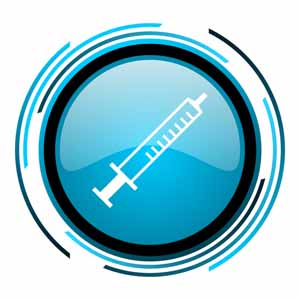Diabetes insulin treatment can be complicated. Insulin is needed to help sugar transfer from the blood to the cells so that the cells can have energy. If your body does not produce enough, or any, insulin, you must take some for this transfer process to work properly. Today, all insulin produced in the United States is now bio-synthesized, rather than produced from pigs or cattle as was traditionally done.
Types of Insulin
 Rapid Acting Insulin starts to take effect within 5 minutes of injection, peaks roughly an hour later, and works for approximately 2-4 hours.
Rapid Acting Insulin starts to take effect within 5 minutes of injection, peaks roughly an hour later, and works for approximately 2-4 hours.
Regular or Short Acting Insulin starts to take effect within 30 minutes, peaks approximately 2-3 hours after injection and lasts for 3-6 hours.
Intermediate Acting Insulin starts to take effect within 2-4 hours, peaks approximately 2-4 hours after injection, and lasts for 12-18 hours.
Long Acting Insulin starts to take effect 6-10 hours after injection and is effective for approximately 20-24 hours.
Characteristics
There are three insulin characteristics that you should be familiar with, basically your diabetes vocabulary test. Onset is the time period that insulin takes to reach the blood stream and begins to lower blood glucose (sugar). Peaktime is the time period that the insulin is at maximum strength. Duration is how long the insulin works to lower blood sugar.
Administration
Injection. This is just like it sounds. Insulin is self injected into the skin using a needle and syringe (the hollow tube that holds the insulin solution). Sometime people use a device called an insulin pen, which simply looks like a pen, but is used to inject insulin.
Insulin Pump. This device, about the size of a cell phone, is worn on the body. A small tube with a needle on it connects the device to your skin and stays connected for several days. Insulin is then pumped into the body at a predetermined rate.
Insulin Jet Injector. This device injects a very fine insulin spray through the skin using high pressure air.
How Much and When?
This answer depends on the person. Some diabetics take insulin three or four times a day, others once a day. The treating physician will determine the appropriate amount of insulin needed and when to take it.
Strength
A good diabetes insulin treatment centers around the insulin strength. The strength, however, will depend upon each individual patient. Generally, all insulin is suspended or mixed with another solution. The most common strength is U-100, meaning it has 100 units of insulin per milliliter of fluid. This strength is the most common in the United States. You should note that other countries may use different strengths.
For example, U-40 strength is used in Europe and Latin America. This is important because if you are traveling in these areas you will need to bring your own insulin or learn how to appropriately match your needed insulin strength to the insulin available in the country you are visiting.
Additives
Insulin contains additives that prevent bacteria from growing and regulates the balance between acids and bases. Other insulin, such as intermediate and long acting, contains additives that extend their action.
There you have it. The introductory course on diabetes insulin treatment.
By Erich Schultz – Last Reviewed June 2012.
